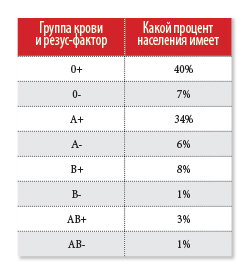In the centuries-old history of the development of medicine, one can hardly find a second discovery so significant in terms of scientific and practical importance as the classification of human blood into groups.
To date, scientists talk about the existence of more than 250 varieties of blood groups, which are combined into 25 systems. But the two most important systems for separating blood groups are taken as the basis in modern medicine: AB0 (or digital: I, II, III, IV) and the Rh factor.
All in pairs
The doctrine of blood groups, like many others discovered in medicine, arose from clinical needs. For centuries, doctors have tried to save people by transfusing someone else's blood. Many of these experiments were successful, but most of them led to severe complications or even death of the patient. The explanation lay on the surface: one blood was suitable, the other was not. But why?
In 1901, the scientist Karl Landsteiner, in his article “On the agglutinative properties of normal human blood”, based on his research, presented and described three blood types: A, B and 0. A year later, his students discovered the fourth group - AB.
The principle of division into groups was based on the ability to stick together two types of antigen proteins (agglutinogens) A and B present on the surface of erythrocytes, and agglutinins a (alpha) and b (beta) present in plasma. All possible variations of connections are reduced to four: AB, Ab, aB and ab.
Thus, people with blood group 0 (I) do not have A and B antigens on the surface of red blood cells, and a and b agglutinins are present in their plasma. Representatives of group A (II) have antigen A on the surface of erythrocytes and b-agglutinin in plasma. Group B (III) are carriers of B-agglutinogen and a-agglutinin. And, finally, the owners of blood group AB (IV) have type A and B antigens on the surface of erythrocytes, but there are no a and b agglutinins in the plasma. The ability to agglutinate is passed from parents to children, like the Rh factor.
Rh factor (Rh) is an antigen (protein) that is also found on the surface of red blood cells. It was first discovered in 1940 by Karl Landsteiner and Alexander Wiener. Experimenting with the blood of rhesus monkeys, they found that a specific antigen was present on the surface of their red blood cells. The identity of the new factor of monkey erythrocytes with human erythrocytes allowed to give it the name "Rh factor". Further it turned out that about 85% of people have this very Rh factor and are Rh-positive (+). The remaining 15% who do not have the Rh antigen are considered Rh negative (-).
The Rh factor is important only for blood transfusion and when monitoring Rh-negative pregnant women. The risk of a Rh conflict arises if the expectant mother is Rh negative, and the future father is Rh positive, and the child has inherited the father's Rh. Penetrating through the placental barrier, the Rh factor of the fetus enters the mother's blood. The woman's body perceives the foreign protein as a danger and begins to fight it, producing protective antibodies. These antibodies pose a threat to the fetus. In a severe form of Rh-conflict, intrauterine fetal death is possible at any stage of pregnancy.

By false rules
“You are what your blood type is,” says Japanese psychologist and writer Masahiko Nomi. Based on 25 years of experience, he established a clear pattern between a person's character traits and his blood type. So, he is convinced that people with blood type 0 are purposeful and strong, the owners of group A are hardworking and accurate, B are creative and constructive, and people with blood type AB are diplomatic and wise.
I must say that the conclusions of Nomi and other psychologists have become so entrenched in the minds of the Japanese that until today the first thing they want to know about you is your blood type. It is on her that the inhabitants of the Land of the Rising Sun pay attention when choosing a life partner, when hiring an employee or selecting an applicant for sports teams.
Echoed by psychologists and nutritionists. Many of them know for sure that you can only be in good shape by adhering to a special diet according to your blood type. So, representatives of blood group 0 (I) should lean on meat, A (II) - eat mostly vegetables, people with group B (III) should exclude dairy products from food, and finally those with blood type AB (IV) , you need to forget about bananas and stock up on soy.
There is even an opinion that the owners of the rarest blood group AB with a negative Rh factor are of alien origin. As evidence, it is given that people with the AB (-) group are smarter than everyone else and are afraid of the cold. Than not "weighty" arguments ...

To date, scientists talk about the existence of more than 250 varieties of blood groups, which are combined into 25 systems. But two are taken as the basis in modern medicine: AB0 (or digital: I, II, III, IV) and the Rh factor.
Anyone who wants to try to live by such principles should know that the connection between a person’s blood type, his character and nutrition has not been proven in any way! However, there are differences between people with different blood types.
Historical aspect
Like belonging to an ethnic group, a healthy person's blood type remains the same from birth to death. But blood type is a category older than race. Not in skin color, but in the blood type is the main difference between people on the planet. Scientists associate blood groups with the stages of human evolution, with the conquest of unexplored territories, with the process of adaptation to a new environment, with the fight against previously unknown viruses and infections. All this was reflected in the blood.
The oldest (half-blood) - 0 or I - originated about 40,000 years ago. The simplest in structure, it became the basis for the formation of the other three groups. I blood type is unique in transfusion, as it suits all people.
The emergence of blood group A (II) is associated with the transition of a person from a nomadic lifestyle to a settled one, from a hunting and gathering economy to an agricultural one. Scientists believe that this happened 25,000 years ago. The majority of the population of Europe has II blood type.
Blood type B (III) supposedly appeared 10,000 years ago. It was a period of merger and migration of races from the African continent to Europe, Asia, North and South America. Now most of the owners of this blood type live in the Himalayas, India, Pakistan and China.
Many experts see a certain pattern between the blood type and the tendency to specific diseases. So, people with type 0 are prone to peptic ulcer, gastritis, and allergies. Type A suffers from pneumonia, diabetes, problems with the cardiovascular system. Representatives of blood group B are more likely to suffer from otitis, cystitis and tonsillitis, and AB are prone to hypertension, strokes, sinusitis and anemia.
Of course, it is impossible to 100% associate the occurrence of the disease only with the blood group. But it is obvious that the duration and quality of human life directly depend on the health of the blood.
Source: rz.com








